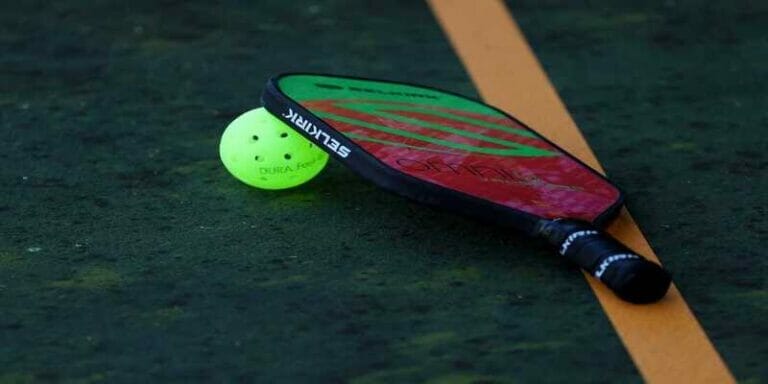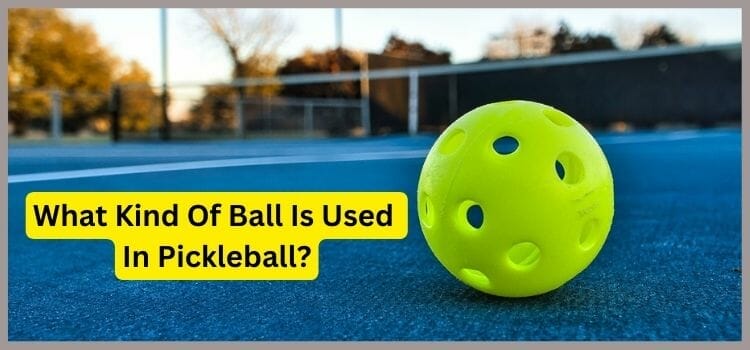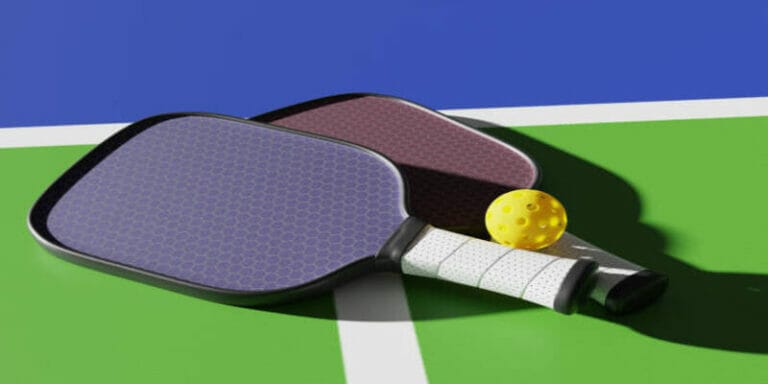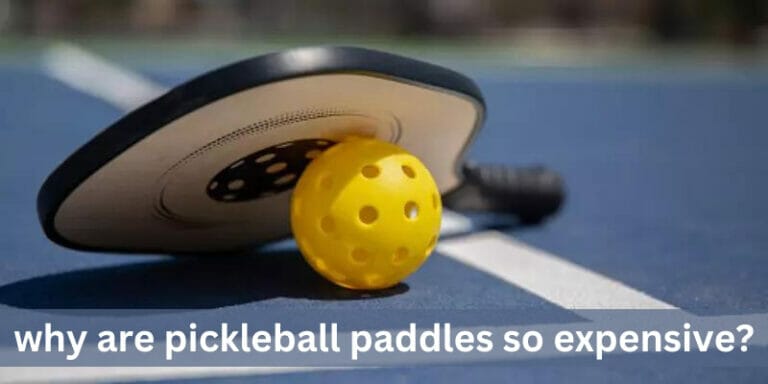Which Pickleball Paddles Are Banned | Pickleball Cutter
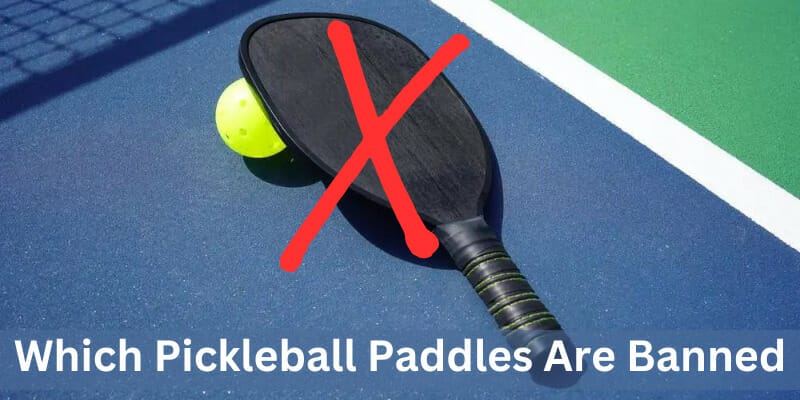
Level the playing field and enhance your pickleball skills by knowing which paddles are banned. Avoid penalties and disqualification with informed play.
Some pickleball paddles are banned depending on the tournament or organization, with specific rules set by the USAPA for competitive play. Paddles made with certain materials or exceeding certain dimensions or weight limits may be prohibited to ensure fair and level competition.
In this article, we’ll dive into the regulations set by the USAPA and explore which pickleball paddles are banned.
Which pickleball paddles are banned
So Let’s Get started
Reasons why a paddle can be banned
The following are some reasons why a pickleball paddle can be banned:
Reason 1: Using Prohibited Materials
A paddle can be banned if it is made using materials that are prohibited by the USAPA, such as certain types of wood or composite materials.
Most paddles are made with materials such as graphite, fiberglass, or composite materials.
However, some materials like metal, wood, or certain plastics may be banned by certain organizations or tournaments because they can provide an unfair advantage over other players.
For example, if a paddle is made with metal, it can create a louder sound when hitting the ball, which can be distracting for other players.
Reason 2: Exceeding Maximum Dimensions
The USAPA has set specific length and width limits for pickleball paddles. If a paddle exceeds these limits, it can be banned from use in competitive play.
The maximum dimensions for a pickleball paddle are set by the International Federation of Pickleball (IFP) and include a length of 17 inches, a width of 7 inches, and a total surface area of 24 square inches.
If a paddle exceeds any of these maximum dimensions, it may be considered illegal and banned from use in tournament play.
Reason 3: Weight Limit
The USAPA has also set a maximum weight limit for pickleball paddles. If a paddle weighs more than this limit, it can be banned from use in competitive play.
The maximum weight for a pickleball paddle is 8.5 ounces, according to the rules set by the International Federation of Pickleball (IFP).
If a paddle weighs more than this limit, it may be considered illegal and banned from use in tournament play.
Reason 4: Surface Texture
Paddles with too much texture on the surface can produce an excessive amount of spin, which can be an unfair advantage for players.
Therefore, paddles with excessive surface texture may be banned.
The surface texture of a pickleball paddle can also be a reason for its ban. The International Federation of Pickleball (IFP) has specific rules on the roughness of the surface of a paddle.
The surface must not have any roughness beyond a certain limit to ensure fair play.
Reason 5: Non-Standard Design
Any paddle that has a non-standard design or is significantly different from traditional pickleball paddles may be banned from use in competitive play.
If a pickleball paddle has a non-standard design, it can also be banned. This includes paddles with unusual shapes or unconventional features that give players an unfair advantage on the court.
For example, a paddle with a blade-shaped design may be banned if it is found to provide an unfair advantage in terms of power or spin.
Reason 6: Safety Concerns
Yes, safety concerns are another reason why a pickleball paddle can be banned.
If a paddle is found to pose a safety risk to players, it may be banned from use in official tournament play.
For example, if a paddle has sharp edges or rough surfaces that could cause injury to players, it may be deemed unsafe and banned.
Examples of banned pickleball paddles
Sure, here are some examples of pickleball paddles that have been banned:
1.Engage Encore MX 6.0
This paddle was banned by the USAPA in 2020 because it exceeded the maximum length and width limits allowed for competitive play.
2. Prolite Titan Pro:
This paddle was banned by the International Federation of Pickleball in 2018 because it did not meet the standard specifications for surface texture.
3. Selkirk AMPED Invite X5
This paddle was banned by the USAPA in 2021 because it exceeded the maximum width limit allowed for competitive play.
4. Head Radical Pro
This paddle was banned by the International Federation of Pickleball in 2020 because it did not meet the standard specifications for surface texture.
It is important to note that these paddles were banned by specific organisations and tournaments, and their ban status may not apply universally.
How to know if a pickleball paddle is banned?
If you’re unsure whether your pickleball paddle is banned or not, here’s a step-by-step guide to help you find out:
1. Check the official rulebook
The rulebook of the tournament or organisation you’re playing in should provide information on the materials, dimensions, weight, surface texture, and design allowed for a pickleball paddle.
Make sure to read through the rules and regulations carefully to determine if your paddle complies with the requirements.
2. Check with the tournament or Organization
If you’re still unsure after reading the rulebook, contact the tournament or organisation and inquire about the specific requirements and any banned paddles.
They should be able to provide you with the necessary information and clarify any confusion.
3. Check the paddle’s certification
Most paddles will have a certification label from the USA Pickleball Association (USAPA) or other official pickleball governing bodies.
Check if your paddle has a certification label and ensure that it’s up-to-date. A lack of certification or an outdated label could indicate that your paddle is banned.
4. Consult with a pickleball expert
If you’re still uncertain about the status of your paddle, consult with a pickleball expert or coach. They will have the knowledge and experience to help you determine if your paddle is legal or not.
By following these steps, you can ensure that your paddle complies with the rules and regulations of the tournament or organization you’re playing in and avoid any penalties or disqualifications.
Testing procedures and certification
Testing procedures and certification refer to the processes used to determine whether a pickleball paddle meets the necessary requirements to be approved for use in official tournaments and competitions.
Here is a step-by-step guide to testing procedures and certification for pickleball paddles:
1.Testing Organizations
There are various organizations that regulate and certify pickleball paddles such as the International Pickleball Federation (IFP), the United States of America Pickleball Association (USAPA), and the European Pickleball Federation (EPF).
2. Submission of paddles
Manufacturers submit paddles to these organizations for testing and certification. They must meet the regulations and guidelines set by the organization.
3.Testing procedures
The organizations use specific testing procedures to determine if a paddle meets their standards.
These procedures may include testing for dimensions, weight, materials, surface texture, and other factors.
4. Certification
If a paddle passes all the testing procedures, the organization will issue a certification indicating that the paddle is approved for use in official tournaments and competitions.
5. Recertification
Paddles may also need to be recertified after a certain period of time or if any changes are made to the paddle’s design or materials.
By following these procedures, players and manufacturers can ensure that their paddles are legal for use in official pickleball tournaments and competitions.
What are the Popular brands of banned pickleball paddles?
As per the rules and regulations of various pickleball organizations, certain pickleball paddles made by specific brands may be banned due to the use of prohibited materials, non-standard design, exceeding maximum dimensions, or weight limit.
List of popular brands that have had paddles banned
Some popular brands that have had paddles banned include:
- Engage Pickleball
- Selkirk Sport
- Gamma Sports
- `Onix Sports
- Paddle Tek
- ProKennex
- Wilson
It’s important to note that not all paddles produced by these brands are banned and it depends on the specific materials, dimensions, and weight of the paddle.
How to Identify Legal Pickleball Paddles?
The following are some things to identify illegal pickleball paddles:
1. Check the size and shape of the paddle
An illegal paddle may be too large or have an unusual shape that doesn’t conform to IFP standards.
The standard size for a pickleball paddle is 17 inches long and 7 inches wide, with a total length of 24 inches including the handle.
2. Check the weight
A paddle that is too light or too heavy may not meet IFP standards. The maximum weight for a pickleball paddle is 14 ounces.
3. Check the materials used
Paddles made from non-approved materials or with non-approved surface coatings are considered illegal.
The IFP has a list of approved materials and coatings on their website.
4. Check the grip

A paddle with a grip that is too thick or too long may not be legal.
The maximum length for a grip is 5 inches, and the maximum circumference is 4.25 inches.
5. Check the noise
Some paddles are designed to make a loud noise when they hit the ball, which can be distracting to opponents.
If a paddle is deemed to be excessively noisy, it may be considered illegal.
It’s worth noting that the IFP has also created a list of approved paddles that have been tested and certified to meet their standards.
If you’re unsure about the legality of a particular paddle, you can check the IFP’s list of approved paddles to see if it’s included.
Expert Tips for choosing an legal pickleball paddle
The following are some expert tips for choosing an legal pickleball paddle:
Tip 1: Determine your playing style
Before choosing a pickleball paddle, it’s important to determine your playing style.
Do you prefer to play aggressively and hit hard shots, or do you prefer a more defensive style of play?
Knowing you’re playing style will help you choose a paddle that is best suited for your game.
Tip 2: Consider the weight of the paddle
Pickleball paddles come in a variety of weights, ranging from as light as 6 ounces to as heavy as 14 ounces.
The weight of the paddle can affect your swing speed and the amount of power you can generate.
Lighter paddles are easier to man oeuvre and swing quickly, while heavier paddles can provide more power and stability.
Tip 3: Look for the right grip size
The grip size of a pickleball paddle is also an important factor to consider.
A grip that is too small can cause your hand to slip, while a grip that is too large can be uncomfortable and affect your ability to control the paddle.
Make sure to choose a grip size that feels comfortable in your hand and allows you to have a secure grip on the paddle.
Tip 4: Choose the right paddle material
Pickleball paddles are typically made of either wood, composite materials, or graphite.
Wood paddles are the most traditional and affordable option, while composite and graphite paddles tend to be more durable and offer better performance.
Consider your budget and playing style when choosing the right material for your paddle.
Tip 5: Check the paddle’s dimensions
The dimensions of the paddle, such as its length and width, can affect your ability to hit certain types of shots.
Make sure to choose a paddle that is legal according to official pickleball rules and that feels comfortable and natural in your hand.
Tip 6: Read reviews and try out paddles before purchasing
Finally, it’s important to read reviews and try out paddles before making a purchase. This can help you get a better idea of the paddle’s performance, feel, and suitability for your playing style.
Many sporting goods stores and pickleball facilities offer paddle rentals or demo days, which can be a great way to test out different paddles before making a final decision.
Conclusion
While most pickleball paddles are legal for play, there are some that are banned due to certain materials or features that give players an unfair advantage.
For example, paddles with cork cores or metal components are typically banned. Additionally, paddles with too much deflection or a certain level of roughness may also be prohibited.
It’s important to check the official rules and regulations before purchasing a paddle to ensure that it is legal for play.
This information can help players avoid penalties or disqualifications during tournaments.
FAQs
Why Is CRBN Pickleball Paddle Banned?
The CRBN pickleball paddle was banned by the USA Pickleball Association (USAPA) in 2021 because it did not comply with the organization’s standards for paddle thickness.
The USAPA sets guidelines for paddle dimensions, weight, and other specifications to ensure fair play and consistency in the game.
The CRBN paddle was found to be thinner than the allowed thickness, which gave players an unfair advantage.
Is The Diadem Vice Paddle Legal?
It depends on the specific version of the Diadem Vice paddle. The USAPA has approved some models of the Diadem Vice paddle for use in sanctioned tournaments, while others are not legal.
It is always best to check with the USAPA or tournament organizers to confirm the legality of a particular paddle model.
Are Carbon Fiber Paddles Legal In Pickleball?
Yes, carbon fiber paddles are legal in pickleball as long as they comply with the USAPA’s guidelines for paddle dimensions, weight, and other specifications.
Many professional and amateur players use carbon fiber paddles because they are lightweight, durable, and provide excellent control.
What Paddles Do The Pro Pickleball Players Use?
Professional pickleball players use a wide range of paddles from different brands, depending on their personal preferences and playing styles.
Some popular brands among pro players include Selkirk, Paddletek, Engage, Onix, and ProKennex.
Some well-known pro players and their paddle choices include Ben Johns (Franklin), Simone Jardim (Paddletek), and Tyson McGuffin (Selkirk).

